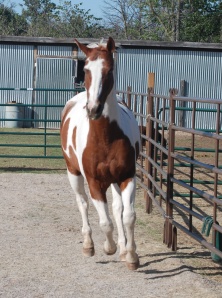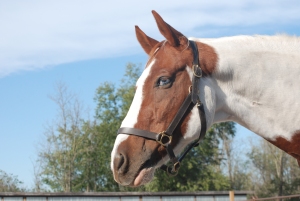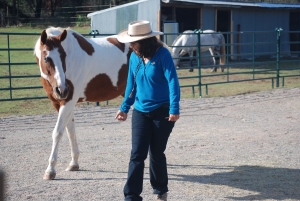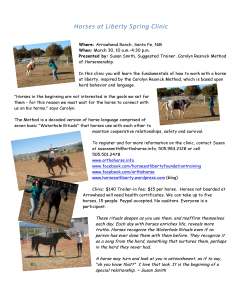This past weekend I attended one day of an animal communication workshop with Leta Worthington, a well known animal communicator who lives in Cerrillos, New Mexico. We were each to bring photos of animals we wanted to work with. I of course, brought my horse pictures, and we worked Patches.
There is a systematic approach to animal communication, which I was to learn, in order to ask them to “talk” to you. Leta and I have collaborated with a few clients in common and I’ve found her insights extremely valuable.
I find that horses “talk” to me sometimes while I’m working on them, and my own horses talk to me as well. Sometimes they might want to get a message through to me via my friend and colleague, Ruella Yates, who lives in Oklahoma. And I have been contacted by her horses for health problems. I’ve even had a very tuned-in human client jump off the table and say, “you must hear what this horse wants you to do!” So this realm of animals communicating is far greater than one might expect upon first hearing about it.
What got me particularly interested in this area of study was my own new mare, Jazzmine, who has essentially been my horse for about two and a half years, although I just brought her home to me in December. She has been appearing to me in my dreams, telling me she is my horse and must live with me. Since knowing Jazzie, other horses including my own, have begun to either appear in my dreams or have given me messages while receiving work. This experience also made me realize this communication has been happening for much longer, only I wasn’t as tuned in to it.
 The reason I chose to work with Patches at this workshop is that I really only hear from Patches through Ruella, so I wanted to see if he would talk to someone else about something that was troubling me in our relationship. Patches has been featured in this blog a lot because he is such a big fan of the Waterhole Rituals and likes to dance. Our relationship is strong. But he tends to freeze up with some activities, so we’re working on this very gradually.
The reason I chose to work with Patches at this workshop is that I really only hear from Patches through Ruella, so I wanted to see if he would talk to someone else about something that was troubling me in our relationship. Patches has been featured in this blog a lot because he is such a big fan of the Waterhole Rituals and likes to dance. Our relationship is strong. But he tends to freeze up with some activities, so we’re working on this very gradually.
The following is Patches’ interview with Pam Egan at the workshop:
Before Pam starts the interview:
Patches: I know, I know, I heard you talking about me.
Pam : What do you want to tell Susan?
Patches: I would go where she wants, I just can’t make myself, even when I want to.
Pam: Why?
Patches: I had power once over everything, once. Then I had no power and I did everything I was supposed to. Then with Susan, I had power again.
Pam: What does power mean?
Patches: It means control. I had control again and I’m afraid to go back to the way it used to be.
Pam: How about with the kids?
Patches: The kids don’t want control. They don’t care if I do what they tell me.
Pam: Do you want Susan to be happy with you?
Patches: Yes, she is happy with me anyway. I have tried. I just can’t do everything she tells me. Maybe if she would give me more time to do it.
Pam: Are you happy?
Patches: I am happy, but I don’t want to be not in control and with no power.
Pam: You know you’re very beautiful.
Patches: I know.
Pam: How about starting with obeying half the time?
Patches: I can do that.
Pam: Will you?
Patches: Yes.
Pam: Thank you. I don’t really know about horses.
Patches: I know. I can tell. We’re the same as other animals.
Pam: I like you.
Patches: I like you too.
When I heard this from Patches, I thought that must be terrible to feel powerless. Horses are all about power. How many horses feel just like him, especially if they’ve changed hands a bunch of times and people haven’t noticed the horse or have simply asked him to do what they wanted without any reward or thank you? Even if people have been appreciative, the horse could have had no say in the matter.
Many training methods don’t give horses a say in what happens to them. Resistance is seen as bad behavior and something to work out of them. Many times trainers only have a 30-day cycle in which to work with a horse.
It demonstrates to me the little struggle between humans and horses; how we are time-driven – “well, why aren’t we progressing faster with this?” And the horse is saying “I think I need more time.” And we’re just thinking they’re being obstinate or we’re not doing our job!
So Patches’ interview really showed me he is still suffering from a case of burn-out and made me realize that there is a resource to listen to him and honor him in a different way. It isn’t about the animal having power over me, it is about being able to recognize each other’s individual power and allow space to heal where needed.
This method of communicating is another resource we have available to us to bridge the gap between horse or human, or any other animal for that matter (the other animals we worked with were dogs and cats). I’m so happy to add it to my toolbox!
You can learn more about animal communication by going to Leta’s website,
Herbs and Animals On the site you can also find and order her wonderful new book, Learn How to Talk to Animals.
**************************************************************************************************************
Private sessions and gift certificates are available for bodywork and liberty work, by calling 505.501.2478 or emailing susansmith@orthohorse.info
Click on this flyer to find out about my upcoming Liberty Clinic to be held March 30th in Santa Fe.






super blog Susan – and good to help making people aware of their abilty to ‘talk’ with their animals and their animals’ – or at least most of them – wish to talk to and with their human 🙂
Thanks, Geerteke. It is so interesting what the animals want to tell us and then, what they might not think is important!
Sir Harry Swanson: “You can’t own a cat. The best you can do is be partners.” I guess this is what your Patches is trying to tell us about horses….
Great point, we always have in mind what we want to achieve, horses don’t. I often find my horses are telling me to just slow down and it’s why I would never take on a horse to train within a time limit. Thanks for sharing with us 🙂
I feel that same way. The Waterhole Rituals that I teach and practice do not have a time limit like the 30- or 60-day limits many trainers use. It takes as long as it takes.
I loved hearing about my friend Patches! Thank you for this very interesting post, Susan!